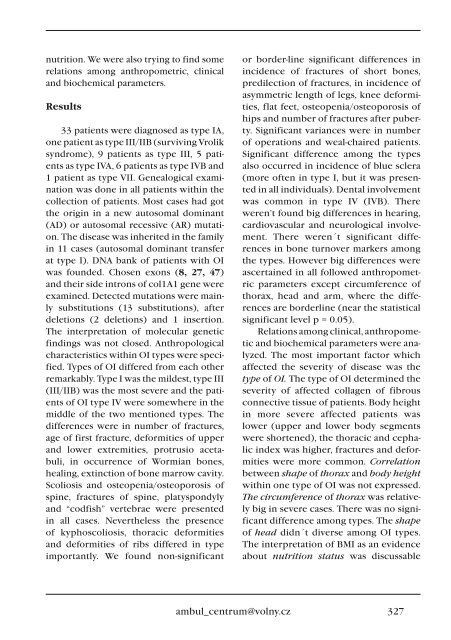Supplementum 3+4/2007 - SpoleÄnost pro pojivové tkánÄ›
Supplementum 3+4/2007 - SpoleÄnost pro pojivové tkánÄ›
Supplementum 3+4/2007 - SpoleÄnost pro pojivové tkánÄ›
Create successful ePaper yourself
Turn your PDF publications into a flip-book with our unique Google optimized e-Paper software.
nutrition. We were also trying to find some<br />
relations among anthropometric, clinical<br />
and biochemical parameters.<br />
Results<br />
33 patients were diagnosed as type IA,<br />
one patient as type III/IIB (surviving Vrolik<br />
syndrome), 9 patients as type III, 5 patients<br />
as type IVA, 6 patients as type IVB and<br />
1 patient as type VII. Genealogical examination<br />
was done in all patients within the<br />
collection of patients. Most cases had got<br />
the origin in a new autosomal dominant<br />
(AD) or autosomal recessive (AR) mutation.<br />
The disease was inherited in the family<br />
in 11 cases (autosomal dominant transfer<br />
at type I). DNA bank of patients with OI<br />
was founded. Chosen exons (8, 27, 47)<br />
and their side introns of col1A1 gene were<br />
examined. Detected mutations were mainly<br />
substitutions (13 substitutions), after<br />
deletions (2 deletions) and 1 insertion.<br />
The interpretation of molecular genetic<br />
findings was not closed. Anthropological<br />
characteristics within OI types were specified.<br />
Types of OI differed from each other<br />
remarkably. Type I was the mildest, type III<br />
(III/IIB) was the most severe and the patients<br />
of OI type IV were somewhere in the<br />
middle of the two mentioned types. The<br />
differences were in number of fractures,<br />
age of first fracture, deformities of upper<br />
and lower extremities, <strong>pro</strong>trusio acetabuli,<br />
in occurrence of Wormian bones,<br />
healing, extinction of bone marrow cavity.<br />
Scoliosis and osteopenia/osteoporosis of<br />
spine, fractures of spine, platyspondyly<br />
and “codfish” vertebrae were presented<br />
in all cases. Nevertheless the presence<br />
of kyphoscoliosis, thoracic deformities<br />
and deformities of ribs differed in type<br />
importantly. We found non-significant<br />
or border-line significant differences in<br />
incidence of fractures of short bones,<br />
predilection of fractures, in incidence of<br />
asymmetric length of legs, knee deformities,<br />
flat feet, osteopenia/osteoporosis of<br />
hips and number of fractures after puberty.<br />
Significant variances were in number<br />
of operations and weal-chaired patients.<br />
Significant difference among the types<br />
also occurred in incidence of blue sclera<br />
(more often in type I, but it was presented<br />
in all individuals). Dental involvement<br />
was common in type IV (IVB). There<br />
weren’t found big differences in hearing,<br />
cardiovascular and neurological involvement.<br />
There weren´t significant differences<br />
in bone turnover markers among<br />
the types. However big differences were<br />
ascertained in all followed anthropometric<br />
parameters except circumference of<br />
thorax, head and arm, where the differences<br />
are borderline (near the statistical<br />
significant level p = 0.05).<br />
Relations among clinical, anthropometic<br />
and biochemical parameters were analyzed.<br />
The most important factor which<br />
affected the severity of disease was the<br />
type of OI. The type of OI determined the<br />
severity of affected collagen of fibrous<br />
connective tissue of patients. Body height<br />
in more severe affected patients was<br />
lower (upper and lower body segments<br />
were shortened), the thoracic and cephalic<br />
index was higher, fractures and deformities<br />
were more common. Correlation<br />
between shape of thorax and body height<br />
within one type of OI was not expressed.<br />
The circumference of thorax was relatively<br />
big in severe cases. There was no significant<br />
difference among types. The shape<br />
of head didn´t diverse among OI types.<br />
The interpretation of BMI as an evidence<br />
about nutrition status was discussable<br />
ambul_centrum@volny.cz<br />
327
















